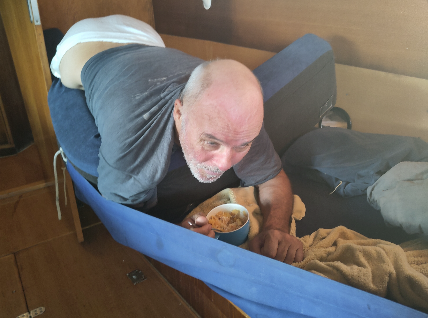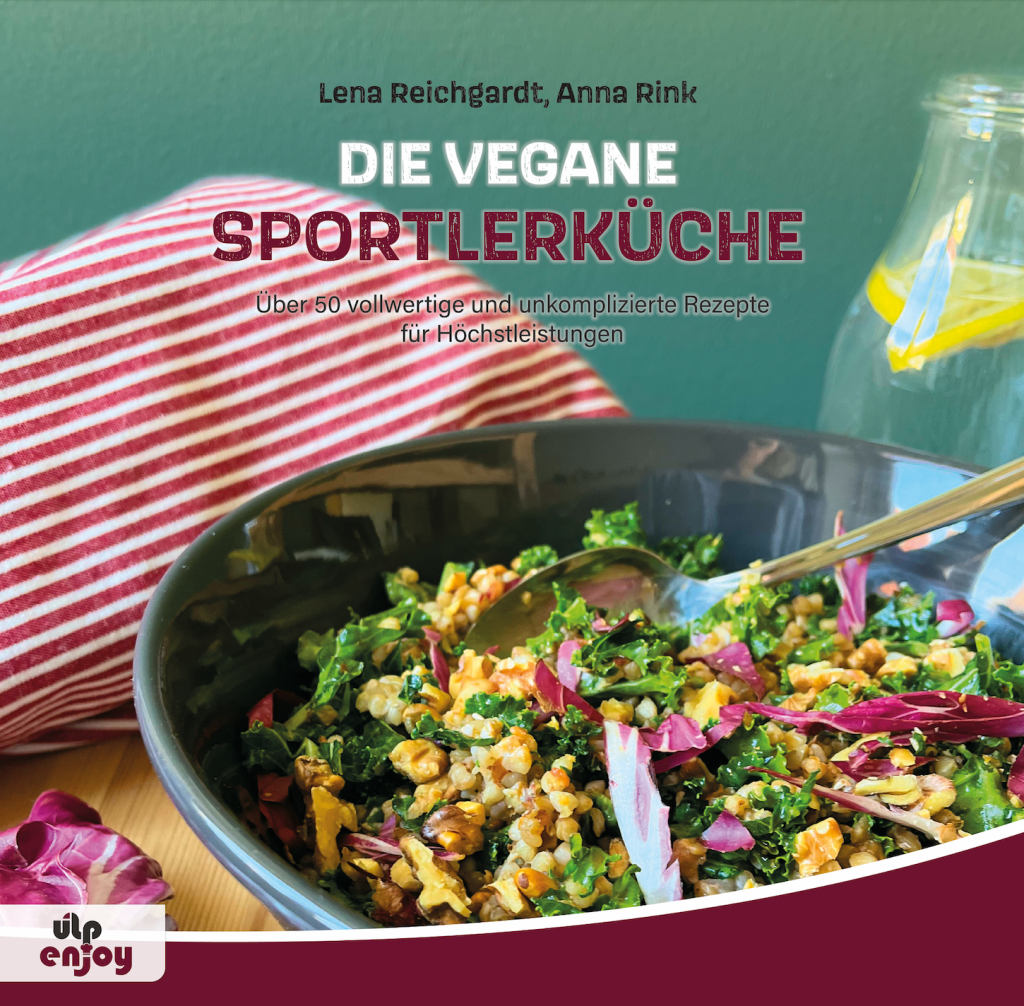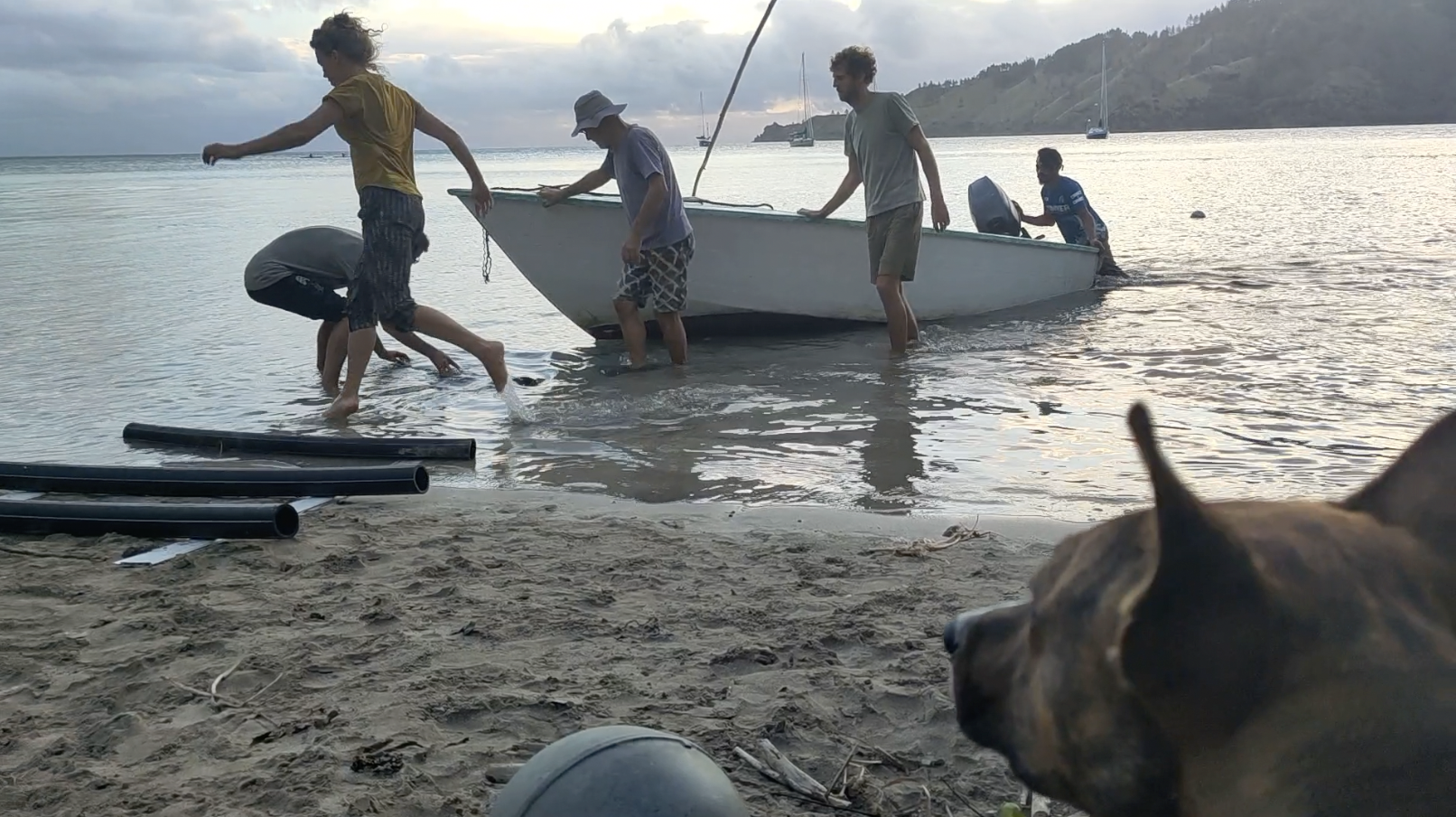Nuku Hiva is the central island of the Marquesas. Taoha’e is the central town. So this is the busy place. The life style here is a great example of sustainable living. It is shown in this movie. Enjoy.
A vertebra’s recovery with the help of a sustainable solution
Two pictures, taken in a week time. Both taken by Jean Luc, who did an awful lot of care the last week. From reanchoring t the Ya to bring me up and down in his dinghy to shore. The last thing he did that so many times, but from now on Peter can do it alone. Lool at the last picture, to the right, with two paddles and our kayak on the background.

Peter, with his sore back and with his bungee belt on, can get the kayak himself from the Ya to this place, just on the side of the quai. With a line along the shore, with two wheels, with the use of the waves, and with some creativity.
Check it out here in this movie.
We bought this kayak because of its sustainability. Its length and its little weight and wind drag make it easy to make speed with only the paddles, so you don’t need an engine.
A dinghy would be way to heavy to hold. The engine would make the entry to the ramp impossible. Moving or lifting such thing would be way to much weight for a sore back. But this kayak has all you want: no engine, and so light that even with a freshly broken vertebra it is a handy thing.
A hurray for the kayak, for this sustainable solution!
Teamwork beats Murphy
We were in the bay of Fatu Hiva, a little island with 300 souls. Let’s sum it up Murphy’s results since he was on boardwere:
- It is the 4th day that Peter lies with an injured back on his bunk.
- Our main anchor did not hold and then hooked up a heavy thing, (like a big crab cage?), to heavy for the anchor motor to lift.
- Our anchor battery has been pushed too hard and it is presumeably dead. We did a reconditioning programme, but Peter guessed it could have too little stamina to deliver the necessary energy to the anchor chain motor.
- We are on our second anchor, on a long rope. The rope could chafe on a rock and finally break, so it is a temporary solution.
- Or temporary anchor place was OK, but the wind turned and pushed Ya pretty close to the rocks.
- Inge does all the work: cooking, anchor watch, deckwork, and nursing Peter, and that is too much.
- Only Inge can move to clear the anchor from that heavy thing, but that needs a pretty technical skill and a fresh mind, no room for mistakes, and some hours of work.

A fellow sailor
In the early morning Inge heard something strange slipping on the uncleared anchor. Kg, kggg, kgggggg, kgrrrrrrr, KLOINK and then nothing anymore. Was that the big thing slipping off the anchor? Inge simply tried if the anchor winch could lift the anchor now. Yes! Slowly but surely the anchor came up. Great, we could take in the second anchor and go for anchoring with our main anchor again!
Inge just started preparing , when a dinghy passed by, with people from another boat: Adrien, Marine and Lionel. They’re on their way to a diving spot. Inge briefly outlined our situation and they said that on their neighbour yacht, there is a doctor on board. A French GP. After their dive they will tell him about Peter’s back; perhaps he pays a visit.
A second dinghy passed with one man, Jean Charles is his name. He offered to help and we could use that. Peter made his way to the engine throddles, Jean Francois pulled in the anchor line, Inge did the other things. We dropped the main anchor closed to Jean Francois’ boat, just where the depth went from 15 meter to 30 meter. It appeared to hold well.
The doctor
Next day, when the wind picked up, the doctor arrived. Alain did the anamnesis with Peter. What he could diagnose was the risk that some vertebra was seriously hit. Peter asked: “Well, here is no medical service whatsoever, so what about sailing with Ya to Nuku Hiva? There is a little hospital with facilities”. Alain responded that any sailing, even an odd move, could damage Peter’s back and he might end up in a wheelchair. To put more stress to this answer, some strong gusts hit the Ya. Alain called a neurologist in Tahiti and in a 10 minute conversation they discussed the possibilities. Meanwhile, more gusts hit the Ya.
5 fellow sailors
Alain just ended the call and again some knocks on the Ya. It is Adrien, Marine et Lionel: “Your boat is moving, it is from its anchor!” Indeed, we were drifting out of the bay, towards the ocean. Time for action right now.
We needed all hands on deck. Marine took the helm, Inge did the engine controls, Adrien and Lionel pulled in the heavy 10 mm anchor chain by hand, because the anchor battery was dead in half a minute. Peter did all the yelling from his bunk: “Go to there and you find this, and you, there you find that!” Meanwhile, Alain (the doctor) exchanged the anchor battery for the spare one.
A next fellow sailor arrived, It was Jean Luc, a free diver. He knew the bottom well and went in his dinghy to point out the best anchor spot.
Within an hour the Ya was anchored again, Jean Luc free dived straight to the anchor on 25 meter deep. He reported back, : “No worries Peter. Although it is deep here, the anchor is dug deep in excellent anchor soil on a great plateau. With your long anchor chain, it will definitely hold, you can leave your ship without any worry.””
A nurse, six fishermen, a stretcher, a pilot and an anesthesist
Meanwhile, the specialist in Tahiti already activated Peter’s transport. Our fellow sailors were just leaving when a fisherman boat already rafted up the Ya. A nurse embarked with 6 strong Marquesian fishermen and a stretcher. They took Peter from the Ya into their boat. his team is too strong and Murphy had no chance to mess about. In the harbour Peter was put up a pickup truck and we went to the soccerfield. There the trauma helicopter landed. Peter was slided in. And a seat for Inge, with a bag of luggage she grabbed in a hurry, and that proved to be exactly what we would need the next days. It was a 150 mile (250 km) flight. Inge had a great view. Peter, on his stretscher at the bottom of the heli, just had pain. But on the end of the ride he was well drugged. When the pilot asked if he was still allright, Peter could say: “Couldn’t do better. But, it would be nice for my wife if you could fly an extra tour around the beautiful island of Nuku Hiva.”
In the next film you can see the whole trip from the boat to the hospital (it includes some blackouts, sorry, caused by the circumstances).
The hospital team
The hospital team in Nuku Hiva was ready and prepared. Peter was put in the radio scanner tunnel. That machine delivered a great slide slow, if you are a doctor. The specialist, still in shorts and T-shirt, showed one picture and told that the a little bone on the Lumbal vertebra #1 was broken. Fortunately, it was not displaced, so no surgery necessary.
Peter stayed for observation in this very friendly hospital, where you still can see that ‘hospital’ has its origin in the word hospitality. Inge could sleep in the same room – a great relief for her, for us.
Peter and Inge stayed here for 3 days. A great time to think these days all over. In general, a responsible sailor does a lot to cut down the risks. However, once Murphy is on board on his chosen time and place and keeps on going, you , despite precautions, despite redundancies.
But, when fellow sailors pop up to help you, Murphy gets in trouble. And, when they start working as a team, till the very detail, Murphy looses. The warmhearted help from fellow sailors, is way too hot for him – he flies away with his tail behind his legs.
Fellow sailor Jean Luc
Jean-Luc called. He offered to keep an eye and take care for Ya. “Anything I can check on board Ya now, Peter?”
No chance for Murphy to get on board Ya.
Murphy’s visit
August 7, still night, the wind suddenly shifted to the North, more against us. So a t 7 o’clock, with changing of the watch, we started the sail change. Peter furled in the outerjib. The furling line slipped, a wave bumped the Ya, making Peter slip, and fall. Unfortunately, he fell with his back exactly on a corner. A burning pain. He stood up, tried to pull the furling line again, again a flaming pain hit in his back. A bit dizzy he held himself to the pole in the cockpit and slowly went down. In a final effort he crawled on his knees all the way to his bunk and went lying on his belly, the least painful position,
Peter was out of service. Inge took over.
And Inge did take over! We were 250 miles from the nearest island. Inge furled in the outerjib, she reefed. Inge cooked. Inge nursed Peter, for every bit, with meals and drinks with a straw because Peter couldnot even lift his head to drink or eat.

Heroin Inge, suffering Peter
Despite the predictions, the wind turned really against. Inge tacked, unreefed, reefed later, she hoisted the mizzen. She even lowered the complete furled outerjib ant stowed it away- normally a job for two persons. On this beating course, the waves put the Ya up and down, including Peter and his sore back. It did not help the healing for sure. For three days Inge slept with the electronic ships alarm on. She navigated us all the way to the bay of Hanavave, Fatu Hiva, the remotest island of the remote Marquesas islands.
Anchoring with Murphy
We entered the bay by night. There, the water was flat, so Peter went on his feet. Very carefully, it took him an extra gram of Ibuprofen an half an hour to make the 3 meters to the cockpit. Now he could check the radar and handle the motor throddle. Inge could lower the sails. We were not lucky, there were 12 boats in this little bay. It took half an hour to find a place for us to drop the anchor.
The anchor did not hold. Finally we lifted it. There was a heavy thing on it. Anchor unclear. Shit. For sure Murphy was on board. Inge pushed the anchorwinch button, but it simply stopped, it was to heavy. We ended up between the other anchored yachts. Peter could find the way out. Meanwhile Peter instructed Inge to get the second anchor and make it ready. That was an anchor without a chain. We would drop the anchor on a deeper spot, so we needed our 200 meter line to secure the holding.
We anchored again, closer to the side of the bay. The line we had to let go was 120 meter. We gave 150, to be very shure. On this place the anchor was holding well. We were happy, and Peter was already for 3 hours on his feet and went straight to his bed.

A night with Murphy
Every boat swings a bit behind its anchor. Also the Ya swinged, and with that long line it swinged pretty much. The wind changed a bit and that made the Ya come very close to the side of the bay. That close, that Inge could even see in the night the waves hitting the pointy rocks. So Inge went looking. She shortened the anchor line. That helped a little bit.
A day with Murphy.
At first light in the morning the the wind changed again. Again Ya went close to the pointed rocks. What to do? Peter has to stay in bed, Inge was tired, and had pretty much work on just cooking, the infirmary and cleaning up the mess a bit. Also the anchor battery was completely empty of all the hassles, and perhaps even damaged. So we’d better set that on a reconditioning program this day and night. Actually, we decided only act, when there is a direct emergency that we hit these luring sharp rocks. So Inge only prepared the kayak to blow up. Then, it was already evening.
Another night with Murphy
Sometimes Inge woke up, looked out of the window and saw only a huge wall. That was the side of that bay. With the waves turning in to shiny foam on the pointy rocks. At night you hardly see distance so for Inge it looked like it was just some meters away, so she jumped out of bed. This way she passed the night.
Peter was already recovering a bit, but hat means nothing more than that he could drink without a straw in his bed. Inge was the only one able to do something, but with the continuous workload and the many lacks of sleep in the night, she simply cannot do everything.
Will it be another day with Murphy? How will this end?
To be continued next week. Teaser: even a helicopter is involved.
Vegan around the world
Anna and Stig invited us aboard Ziganka III and told us all about how they love sailing and visiting places that are off the beaten track, like Gambier. We both love slow sailing.
We discussed how COVID influenced our decisions to embark on our journeys differently. Anna and Stig postponed their trip to July 2022. During COVID, Anna wrote a truly beautiful book on vegan cooking.

Anna and Stig on board of Ziganka III. Anna proudly shows her cookbook over a great vegan lasagna
Anna’s first cookbook: Vegan cuisine of the Alpes
Being a real sportswoman who loves hiking, cycling and climbing, she dedicated the book to the traditional cuisine of the Alpes. She turned her 100 favorite dishes into new classics: the vegan version. Stig was happy to be her guinnee pig, so all recipes are tested on live human beings and all the pictures in the book are of real food, in their kitchen in Munich.

Before visiting Ziganka III, we went to Tauna Beach to watch the sunset
On board of Ziganka III she explains that it is relatively easy to replace basic recipes with vegan options. And, if you do that, you can always add non-vegan ingredients for vegetarians or flexitarians. The pictures in the book look appetizing and invite you to explore this new way of cooking. A great accomplishment!
A second cookbook
After Anna and Stig set sail in 2022, she started working on her second cookbook. However, this time she wrote it together with her colleague and friend Lena Reichgardt. Lena was at the time training for the Ironman in Hawaii. The theme of the book: Vegan Sports Cuisine. In the book, they introduce the reader to recipes that make it possible to train hard and still get enough protein and all the other nutrients. Just so you know: Lena Reichgardt finished the Ironman in Hawaii 2023, on a vegan diet.

The cover of Anna’s second cookbook: even tough sports are possible on a vegan diet
Towards vegan cooking
Anna gave us some tips for introducing vegan elements in our lifestyle:
- Use whole products like nuts, grains, seeds, fruit, veggies, beans etc.
- Add enough fat use avocado, nuts, coconutmilk, olive oil etc.
- Add enough flavor to your dishes. Depending on the dish you can think of green herbs, capers, dried tomatoes, dried mushrooms, smoked paprika powder, yeast flakes, miso, lemon, jalapeño, garlic, harissa, tahini, mint, kimchi.
- And if you go ‘all vegan’ you need to watch your B12; supplements are easily availably around the world, even in toothpaste.
Creating Garbage
Once, it must have been in the 1950’s, there was some marketing man (or woman) who had the ingenious idea to use plastic mainly for throw away consumption. Ingenious, because for throw away use, your plastic industry business runs for ever.
Does anybody know who he or she was? Because today, 40% of this wonderful durable material is to throw away, or ‘single use’ as it is called objectively.

Our consumption of goods and foods has grown about 10 fold. Since the 1950’s, our plastic use has grown till more than two hunderd fold. Estimated for 2050, it will double again; it will be near one billion ton. To give you an idea: Boyan Slat’s internationally reknown Ocean Cleanup programme caught half a ton in one year. So that is 0,00000005 percent. Just as always at the end of the line in environmental issues, we will not solve it this way.
Cooperate in creating garbage?
Just as many problems, best is to prevent them. Don’t be part of the process. Don’t buy it, don’t work for it. Don’t participate in creating garbage.
Let’s work out a simple thing as tea. The teabag. Check the movie:
Not when you buy tea from brand. Then they make a big fuzz of it. Japanese people have a complete ritual for making a pot of tea, and here, the A brand offers you this rituall by creating garbage:
- You take off the cellofane, and throw it away. Garbage.
- You take the box and throw away that box. Garbage.
- You open the plastified paper around the teabag and throw it away. Garbage.
- You take off the plastified label from the teabag and trhow it away. Garbage
- When you finish your tea, you throw away the teabag, that constists of plastics (polyester and more). Garbage.
This is just an example. Think of cookies, candies, coffee machine capsules, and all kind of devices, from coffee machines to tools. It can be plastic-in-plastic-in-plastic, but often it is a mixture of plastified paper or cartboard.
Refuse, and save time, save money, save the environment
Already for 40 years the packing industry made covenants all over the world to reduce the plastic sorts to only two or three, to make at least the recycling possible. But it is the same wild west like in the 1950’s. So, don’t count on the industry.
For you, he alternative is extremely simple: Refuse to cooperate creating garbage. For tea: put some tea in a tea ‘egg’. That is all.
Roots of Catholicism in Gambier
Characteristic of the islands in Gambier are the white churches and chapels. All Catholic. The services are in Managerevian and French, and some parts even in Latin. How did Catholicism reach these islands and root so firmly that this religion seems still very much alive in Gambier today?

Altar of St. Michael’s Cathedral, Rikitea, with the Sacred Hearts of Mary and Jesus and mother-of-pearl decorations.
The penultimate king of Mangareva and the Gambier islands, Te Maputeoa Gregorio I , played an important part here. He ruled during the transition from traditional beliefs to Catholicism. To avoid a coup by his uncle, he sought the protection of the church. He even agreed to dismantle the traditional sacred place Te Keika marae in Rikitea, so that St Michael’s Cathedral could be built here. So, now we know the roots, and we know the marriage of church and state creates deep roots. But how to keep these roots alive now the last king died more than a century ago?
Mangareva: Rikitea
The centre of religious activity in Gambier is St Michael’s Cathedral in Rikitea, the capital of Mangareva. It is the largest in Gambier. The two hearts that you find in al churches (see picture of the altar in the Cathedral above) refer to the Congregation of the Sacred Hearts of Jesus and Mary. This was the order of the founding missionaries, Honoré Laval and François Caret.

St. Michael’s Cathedral in Rikitea
The priest of St. Michael’s Cathedral is an energetic man who engages the whole community in the service. The lyrics of the songs are shown on a powerpoint so even guests can sing along. Some illustrations of Jesus, Mary and the pope flash by. A lady in white plays a central role in the sermon: she directs the singing. And, during the sermon, several members of the church, also dressed in white, take on parts of the service by telling their stories. They put their hearts in it, which makes it really personal.
This is not the ‘one-man-show’, typical of the traditional catholic sermon. With this priest firmly rooted in his community, we are not surprised to find him working on a construction site. When we greet him, we ask him about the procession of the statue of Notre Dame de Paix from Akamaru to Rikitea. He explains that the statue is already in Rikitea, this will be celebrated 15th of August.

Statues of Holy Mary in St. Michael’s Cathedral, Rikitea
Akamaru
So, when we visit Akamaru Island, we know we will not find the famous statue. However, the church of Notre Dame de Paix is in beautiful condition, and the garden and lanes look great. The lady who meets us, tells us that all churches in Gambier were built in approximately the same time. The missionaries supervised the jobs going from island to island. Our hostess proudly adds that the Notre Dame de Paix was the first to be inaugurated, because Akamaru was the landing place of Honoré Laval and François Caret in 1834. This is probably also why the statue of Notre Dame de Paix plays such an important role in the yearly procession from Akamaru to Rikitea and back.

Freshly painted church of Notre Dame de Paix in Akamaru
When we arrived, the islanders had just finished painting the church for the festivities of the pilgrimage. The population of Akamaru consists of approximately 10 persons, but, as our hostess explains, fortunately there is always someone who can say the mass. And in return, the islanders take really good care of their church.

Altar of Notre Dame de Paix in Akamaru, with some flowers on the empty spot of the statue
Taravai
Bob Marly’s song ‘one love’ accompanies us on our evening walk on Taravai Island. During the festivities for ’14 Juillet’ we supported the restoration of the church by buying some delicious traditional food (poisson cru, cooked yams, breadfruit, bananas, and a pork stew). And indeed, this church dearly needs maintenance. It is in progress, but we hope the termites respect the work as much as we do.

Sacred Hearts on the walls guarding the church in Taravai; Ya seen through the gate of the wall

Sacred Hearts in Taravai’s church
Our guess: the roots are in the hearts
The missionaries of the congregation of the Sacred Hearts of Jesus and Mary engaged the whole population of the Gambier Islands in building the churches. Mangareviens are still proud of having played a central part in building the cathedral in Tahiti. By engageing them, the missionaries have embedded the Catholic belief in the hearts of the men and women of Gambier. And this continues in the way the priest and his helpers share the care for the religion, traditions and buildings with the community. This keeps the roots strong.
Slow Pleasure III – All you can eat of a coconut
Manon created a paradise on Agakaouitai, a small island near Taravai, one of the islands of the Gambier archipelago. He invited us and taught us all what you can do with, and eat from a cocunut. The way from the tree, through your hands, ending up in the special coconut milk that one ferments (Gambier cuisine) to cook your fish with.
Enjoy, like we did, in the next movie
We just departed from the Gambier Island and you can follow our Pacific Ocean passage to the Marqueasas here:
Map
Dogs and finances
How to ‘sell’ the enumeration of the French subsidies to the people in Gambier, French Polynesia, and to France? First, by celebratiing the Quatorze Juillet., With a French ‘defilé’ That works. The French officials came.
But the mayor’s speech consists of the enumeration itself and that doesnot attract the Polynesians, nor we visitors. But very smart, the chairs of the grandstand were facing the field. The Polynesian dogs -friendly as always, and used to public- make a sweet and loving attraction.

Slow Pleasure I – Supervising the Job
Manoun’s boat had to be repaired. So the crew from the Awa, the Long John Silver, Ziganka en Ya pulled up their sleeves and pulled the boat ashore and flipped it over.
Such a serious job needs serious supervising. You will see how it’s all done.








